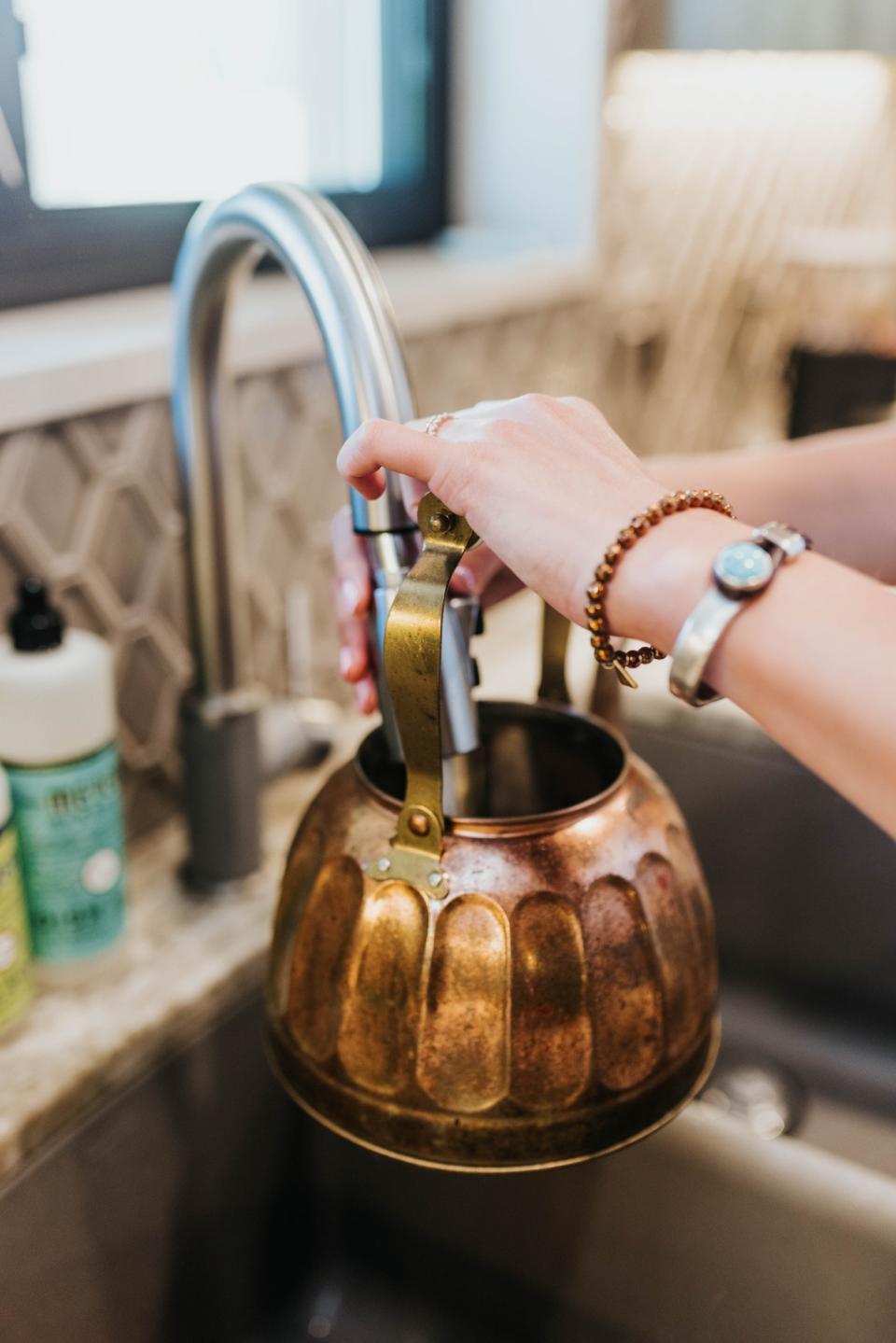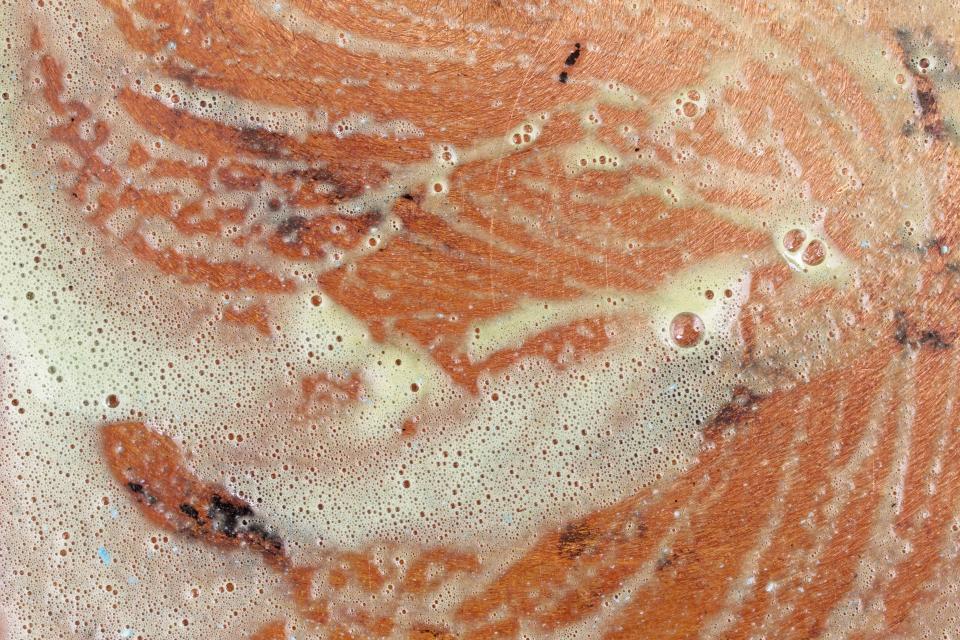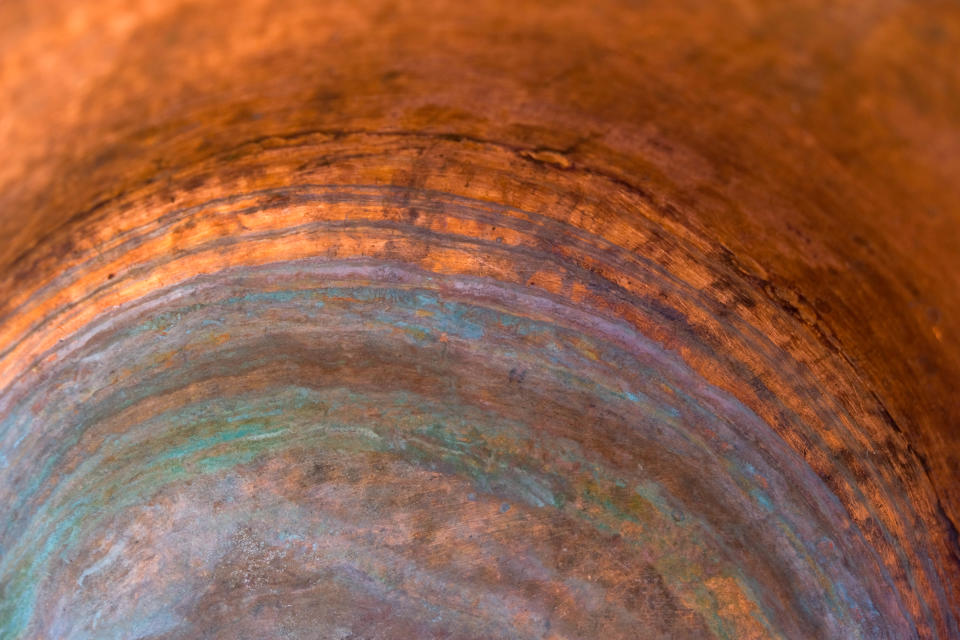How to Clean Copper: Banish That Tarnish and Bring Back the Luster

Illustration: Ellie Schiltz/Getty Images

Woman runs water from kitchen sink into brass tea kettle to heat up
Learning how to clean copper shouldn’t be intimidating. The material’s charming sheen is undeniable, but whether you’ve snapped up a copper pot, pan, mug, or bowl, you’ve doubtlessly been left with one question: How do you remove tarnish and clean copper? The soft metal is prized for its ability to conduct heat, but it does require a little more TLC than other materials, and grime can easily build up, so it’s important to care for copper properly. “Depending on the lining of one’s copper cookware, it’s possible to make mistakes when cleaning,” says Mac Kohler of Brooklyn Copper Cookware. But when copper is well cared for, it pays off in decades of use and beauty in the kitchen.
Read on for some cleaning tips that remove tarnish from copper pans, copper pots, and many other copper goods.
What is the easiest way to clean copper?
Before cleaning copper, check to see if the piece has a lacquer finish, as the cleaning methods change depending on its presence. To figure out if your copper item has lacquer, lightly rub the surface of the copper with a microfiber cloth dipped in white vinegar and baking soda. If nothing happens, the test proves the piece is lacquered. Clean lacquered copper with cups of water and a mild dish soap. Wipe the residue with a dry cloth to finish. If tarnish is removed, your copper items are not lacquered, and you’ll need to clean the item following the steps below.
How do you remove oxidation from copper?
Tarnish is a layer of corrosion that occurs when metals—including copper, silver, and brass—are exposed to oxygen, water, and air over time. It’s a completely normal reaction, but it can turn your shiny copper household items into dingy and brownish pieces that have lost their luster to moisture, dirt, oils, and harsh chemicals. That’s why the surface of copper can range from patina aqua green to dark amber.
To keep tarnish at bay, you have to polish copper pots and pans every six months with a specialty copper cleaner and a microfiber cloth. Use the same approach if you have a copper sink or countertops. The best way to combat naturally occurring ‘tarnish’ is by applying a natural acid, such as lemon juice or white vinegar, says Carol Mehas, cleaning expert and founder of Arbour Natural Cleaning & Laundry Products. “Turns out that efficient copper cleaners are readily found around the kitchen,” she says.
If you don’t want to go the DIY route, look for a cleaner with natural ingredients. Amazon carries copper-friendly cleaning products like Bar Keepers Friend and Wright’s Copper Cream. When using one of these products, make sure to spot-test it first. “Always follow the directions carefully to be sure you don’t cause damage by rubbing too hard or letting the paste sit on the copper surface for too long,” says Mehas.

What is the best homemade copper cleaner?
If you want to skip store-bought cleaners in lieu of a homemade mixture, it’s easy to do with household ingredients you have on hand. Here, four ways to clean copper naturally:
Lemon juice and baking soda
This method works best for badly tarnished copper. A simple homemade copper cleaner to banish tarnish can be made by combining lemon juice with baking soda and stirring until mixed completely. Once mixed, apply to the copper surface and buff in a circular motion using a soft and clean cloth. Rinse and dry.
Ketchup
For one of the simplest DIY cleaning techniques, apply a layer of ketchup to a copper pan or copper sink, and rub the condiment all over the surface. The tomatoes in ketchup contain an acid that helps remove tarnish. Rinse and dry.
Lemon and table salt
A super way to polish copper is to cut a lemon in half and apply table salt to the pulp. This creates a natural abrasive sponge. Rub the lemon on the patina surface of the copper cookware. Use salt as needed to remove stubborn tarnish. Rinse and dry.
White vinegar and table salt
The combination of white vinegar and table salt is yet another option for making a reliable copper cleaner, especially for a copper sink or countertop. Create a paste using white vinegar and salt. Apply to the surface, and buff using a soft cloth. Rinse and dry. If dirt collects in any dents, or if you’re cleaning delicate copper jewelry, use a toothbrush to gently scrub the grime away.
How can you prevent copper from tarnishing?
While tarnish is completely normal, the process can sometimes be slowed down, meaning your pots will sparkle for longer and you’ll have to deep clean them less frequently.
There are some clear coat varnish products for copper, mostly for outdoor use, such as copper downspouts or weathervanes, says Mehas. You can find these products on Amazon, such as Guardsman Weather Defense. “However, eventually, copper will interact with the air and the oxidation process can not be stopped,” she adds. Therefore, vanish should be applied once again directly after cleaning.
If you have any particularly precious copper pieces, keep them in a cool, dry place, to minimize their interaction with the air. For example, copper jewelry or coins can be kept in a thick velvet pouch. “This will slow the oxidation process considerably and require less maintenance,” explains Mehas.
How do you clean very tarnished copper?

Copper surface of the inner part of the copper pot. Oxidation of copper.
Regardless of whether you have a lacquered finish or not, you’ll want to prep before you polish copper. This is especially helpful with very tarnished copper. Start with a gentle wash. Get your copper sudsy with dish soap and warm water. Use a soft sponge and a bit of elbow grease to get the grime off. Copper pots are generally lined with stainless steel or tin. This initial cleaning is gentle enough for either lining.
Notice some damage on your copper pot or pan? Maintaining healthy and clean copper pans goes beyond just polishing. “In the case of a tinned pan, the solution is to re-tin the pan,” Kohler says.
What mistakes should you avoid when cleaning copper?
“Copper is a very sensitive material, and should be treated with care,” says Mehas, noting that while it can be high-maintenance, the upkeep is also worth your effort. To keep that lovely luster around, avoid abrasive products altogether when cleaning copper—even if they advertise themselves as safe, they can score stainless steel and tin, Kohler says.
Although Kohler admits that the salt trick works well, he warns against scouring pans too vigorously. “In the case of stainless-steel-lined copper, the most frequent mistake is scrubbing cooked-on residues with salt,” he says. “If rinsed thoroughly, this can be harmless, but often salt is ground if worked aggressively. These stranded microcrystals can then pit the stainless steel irreparably.”
“Once the metal is chipped or pucked, it can be susceptible to corrosion that can not be reversed and will compromise the performance,” adds Mehas. She suggests using fine table salt only to avoid damage and yield the best results.
Tara Steffen, marketing manager at French copper cookware manufacturer Mauviel, warns against putting copper in the dishwasher. “The heat, combined with the detergent will ruin your pots for good by removing the well-earned seasoned surface and heat conducting properties,” Mehas agrees.
You might also want to consider skipping polishing copper cookware and embracing patina. Let your copper age naturally. “In the case of copper, a patinated surface is becoming harder and more thermally efficient,” Kohler says. “Professional chefs cultivate a good, dark patina as one does bloom on wine grapes; it improves what the thing is supposed to do.”
Originally Appeared on Architectural Digest
More Great Stories From AD It Yourself
47 Kitchen Organization Ideas That Declutter Cabinets, Countertops, and More
The Cringiest DIY Trends According to TikTok’s Favorite Designers, Decorators, and DIY’ers
How to Propagate Pothos Plants at Home: A Step-by-Step Guide
Not a subscriber? Join AD for print and digital access now.
Browse the AD PRO Directory to find an AD-approved design expert for your next project.


